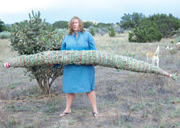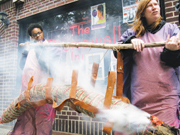Part of the ‘Solution’
The new exhibit at DiverseWorks asks an old question.
By Marene Gustin
What is progress and is it killing us? That’s a question that’s been batted about for centuries. Was it progress that did in the Roman Empire and the mysterious civilization on Easter Island? At a time when the globe is shrinking and carbon footprints growing, it’s a question that weighs on the minds of many, including artists.
“Why did those civilizations fail?” asks Janet Phelps, curator of Solution at DiverseWorks through April 18. The idea behind the exhibit came from a discussion about the award-winning Ronald Wright 2004 book A Short History of Progress, which warns that “now is our last chance to get it right.”
“What did they do wrong and are we doing something wrong as well?” ponders Phelps. “It’s a depressing topic if you listen to all the bad news constantly, so I wanted to put together a show that had a positive message. I felt the nine artists I chose would all have a solution, no matter how small or personal, just a positive take on the problem.”

“Janet was asking artists to create solutions that were a little bit oddball,” says New York-based multimedia artist Christopher K. Ho. “Sort of quirky.”
So he did. Ho came up with Monumental Compost Heap. “It doesn’t make sense, does it?” he asks. “It’s a compost heap and it’s monumental.” Just how monumental remains to be seen—DiverseWorks put out a call for compost and it’s still coming in. Around the compost is a perimeter of recycled wooden pallets in the footprint of the Sam Houston equestrian statue in Hermann Park. The whole thing sits across from DiverseWorks next to a trash bin. “It’s a witty juxtaposition,” laughs Ho. Hopefully, the compost will get recycled after the show and not thrown in the trash.

Another of Ho’s works in the show is his 2008 Lesbian Mountains in Love, a split screen showing Mount Rainier in Washington State and El Popo in Mexico City. “They fell in love at the earth’s core,” fantasizes Ho, “but were separated as the earth changed and now they wait to be reunited. Obliquely, they represent the progress of time.”

Other pieces in the exhibit feature video, sculpture, photography, and sound. But only one features a fur suit. Jeanine Oleson stitched it together from furs she bought on eBay as a reference to Gilgamesh’s animalistic counterpart. “It’s sort of a perverse take on a return to nature,” she says. “I deal with symbols of enduring hope—animals, unicorns.” And a 10-foot-long smudge stick, which she used to cleanse parts of New York City, including Wall Street, which, last we heard, could use the help.

“It was an über cleanse,” Oleson says. “It was a statement, but you never know, it might help.”
“I just want people to think about being positive,” sums up Phelps. “How do we look at life and the world? Can we change? It’s all so doom and gloom, and people are scared right now. I just want people to know there is hope.”
And really big smudge sticks.
Solution
Curated by Janet Phelps, Solution runs through April 18 in the DiverseWorks Main Gallery, 1117 East Freeway, 713/223-8346, diverseworks.org. Gallery is open noon to 6 p.m., Wednesday through Saturday. Admission to the gallery is free.
Marene Gustin wrote about Rice University’s play, Stop Kiss, in the March issue of OutSmart.
PHOTO CAPTIONS
Burning woman: “Something queer was happening on the Pier!” says Jeanine Oleson. “We rolled down Christopher Street [in New York City], smudge a-smoking, to help dissipate bad energy in a queer space due to gentrification. We ended at the Stonewall Inn with readings of historic homo-texts.” Oleson brings her giant smudge stick to Houston this month as part of DiverseWorks’ Solution exhibit. A ritual originally used by indigenous American Indian shamans, smudging is believed to be a means of spiritual purification. The wrapped herbs are lit, much like a cigar, with the smoke absorbing and clearing away negative energy.
Inset: Oleson proudly displays her humongous smudge stick.











FB Comments